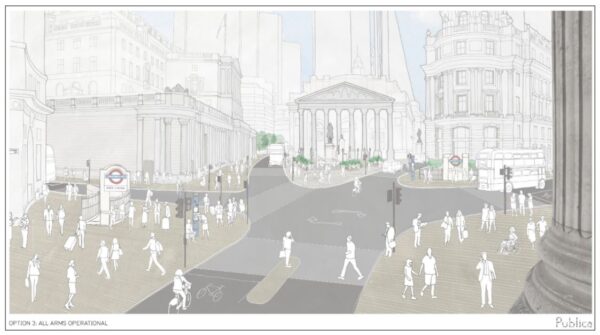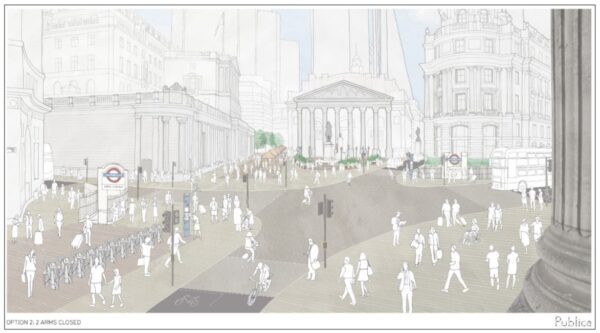Following a trial restriction on road traffic through Bank junction, the City of London has approved the intent to pedestrianise the junction over the next few years.
A safety experiment that saw road restrictions applied so only buses and cycles were allowed though was a success and was made permanent in September 2018, however that was always intended to be just a temporary measure ahead of a revamping of the junction.
Elected members have now voted to proceed with the next stage of the long-term transformation.
The vote follows a decision to put the matter on hold last February until a more detailed report could be produced on the impact of the traffic changes.
The vision looks to retain the ability for some vehicle access while achieving further restriction of two or three arms of the junction to create an area that prioritises pedestrians and cyclists. A number of concept images show the pedestrianisation levels ranging from significantly widening the pavements through to a full pedestrianisation of the junction.
It seems likely though that option 2, a hybrid of the two extremes, with some roads closed and others narrowed will be the one carried forward. Anyone who squeezes around Mansion House will appreciate how crowded the pavement is and any of the options would be a huge improvement, for pedestrians at least.
The need for pedestrianisation is driven not just by the desire to improve the area, but also as data shows that the number of pedestrians using the junction has risen in recent years. With the completion of works to upgrade London Underground’s Bank Station due in 2022, these numbers are expected to only increase.
Proposals for the next phase of work, expected later in 2019, will investigate the future potential for highways alignment, public realm designs and achievable vehicle mix.
The City is now working on a plan due to be published around the middle of the year outlining how it will proceed with the works.










It’s great to see pedestrianization programs, but London needs to start joining these up, otherwise you end up with a patch of good public realm surrounded by utterly snarled roads, I know it’s unfashionable, but businesses still need to get deliveries and people can’t always get everywhere by bike, we HAVE to address East/West routes because currently they’re just pushing the problem around, from the Embankment, to the city, to Stamford Street, to Borough Road to Old Street… it’s not fair to kick the can down to the poorer areas (which is definitely what’s going on).
Pedestrianising Threadneedle Street as shown in the third picture would seriously mess up buses westwards from Liverpool Street.
Time and again on the continent, you’ll see major cities ban everything that moves from their Places/Piazzas/Squares. Deliveries are ‘out of hours’ and woe-betide you if you’re late back to your little b&b in Florence for instance as you’re very likely to get a free shower from the enormous street-washing bowsers.
Bank junction should be completely vehicle-free. It’s a special case as there is a decent choice of surrounding diversion routes and they’re not residential, so why don’t they just jump to it? It would set off the beauty of the buildings like nothing else.
If it does work and gets the go ahead then I think it will make it safer for pedestrians and cyclists. And to divert traffic away from the pedestrianised area.
I regularly walk through the City of London at times when the traffic is low like Saturday/Sunday mornings or even some weekday afternoons when the weather is sunny.
It is a great place to stretch your legs and even on a Sunday morning, there are places to get a nice coffee. There is also lots to observe from some ancient churches to the Victorian masterpiece of Leadenhall Market.
More pedestrianisation and other measures that improve the walking experience are to be welcomed.
How about more statues and other works of art in sensible places?
The complete pedestrianisation will concentrate buses onto other junctions thus leading to problems elsewhere. Perhaps a single core bus route through the junction might be a compromise?
As a pedestrian who regularly uses Bank, the greatest problems I’ve encountered all involved cyclists including failing to stop at red lights /riding on footways (including charging through masses of pedestrians) /ignoring pedestrians trying to cross the road between otherwise stationary traffic.
However, across London little appears to be done to address this.
Gabriel says: “As a pedestrian who regularly uses Bank, the greatest problems I’ve encountered all involved cyclists including failing to stop at red lights /riding on footways (including charging through masses of pedestrians) /ignoring pedestrians trying to cross the road between otherwise stationary traffic.”
As a fellow commuter who walks to/from Bank, I have never encountered anybody riding a bike on the footway at that junction. On the other hand, pedestrians crossing “between stationary traffic”, i.e. against the red man (the very thing you complain about cyclists doing) could cause problems for those cycling.
Personally, I am in favour of the significant reduction of motorised traffic that has already taken place here (but making it 24/7); any of the three illustrations would be a significant improvement from the pedestrian point of view, but I doubt whether it’s practical to go for full-scale pedestrianisation.